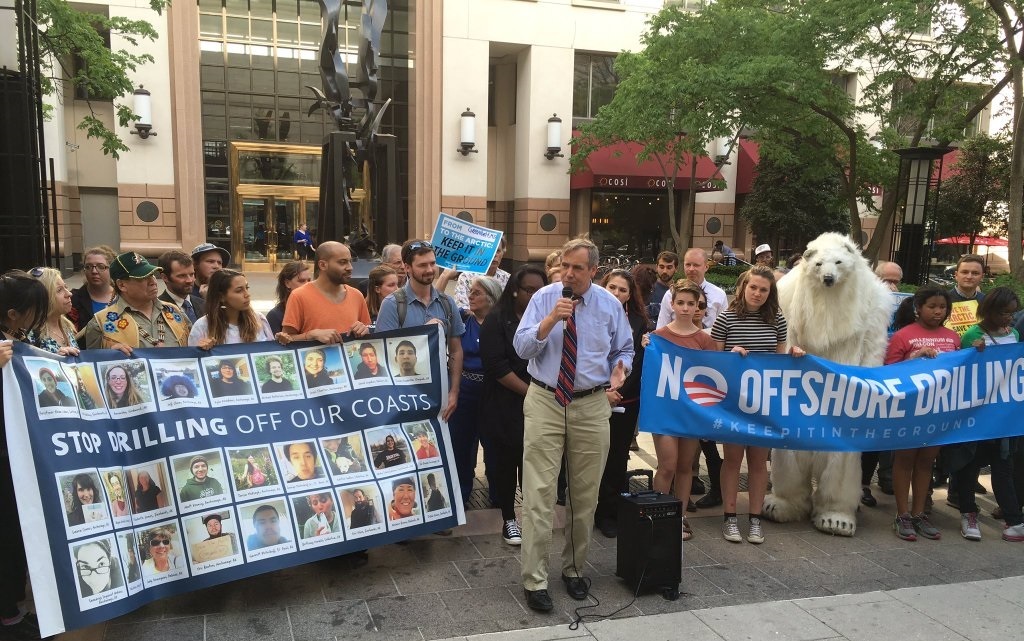What A Difference A Year Makes

Above, Senator Jeff Merkley of Oregon speaks to more than 100 people in Washington, DC, at a May 2016 gathering in opposition to proposed leases in Alaska and the Gulf of Mexico. (Photo: Alaska Wilderness League)
From fighting Shell as it journeyed to start drilling in the Arctic, to finding ourselves a big step closer to protecting the Arctic Ocean from development, the difference from last year to this couldn’t be more dramatic.
June 2015. Throughout the summer, opposition intensified against Shell’s Arctic misadventure. Hundreds of activists gathered in kayaks in Seattle to protest Shell’s Arctic drilling program and its use of the city’s port as a base for its Arctic drilling fleet. From that point, Arctic development became front-page news and “kayaktivism” was embraced by citizens across the country, becoming a powerful rallying tool in the fight to protect our climate and end offshore drilling.
Kayaktivists in San Francisco make their voices heard. (Photo: Greenpeace)
In July, citizens across the country banded together for the “Shell No” Day of Action. With more than 20 events in 15 different states – which included speeches by a U.S. Senator, a Congresswoman, and numerous other local elected officials – the nationwide protest continued the kayaktivist movement that began in Seattle. We called on President Obama to stop Shell – or any other oil company – from drilling in the Arctic Ocean. And the world turned its attention to Shell yet again when its damaged Fennica icebreaker was delayed leaving Portland, Oregon due to additional protests.
(Photo: Greenpeace)
Shell struggled on, but after a second failed Arctic venture in four years, the company announced that -after seven years of mishaps and $7 billion in lost investment- it was putting an end to its Arctic Alaska quest “for the foreseeable future.”
Shell’s Polar Pioneer drill rig. (Photo: Alaska Wilderness League)
Fast forward to June 2016, and Shell, ConocoPhillips and others have relinquished most of their leases in the Chukchi Sea. Now, but a single lease remains. Of the hundreds of leases sold to Big Oil in 2008, Shell will retain one lease in the Chukchi – the site of last year’s drilling –- to retain the rights to the data it collected there.
The focus has shifted from the here-and-now – Shell and the threat of current development – to the future. Already, the Obama administration has canceled Chukchi Sea Lease Sale 237 and Beaufort Sea Lease Sale 242, the proposed 2016 and 2017 lease sales for the Arctic Ocean. But still on the table is the 2017-2022 five-year plan for offshore leasing. A draft offshore program released back in March removed the Atlantic from consideration, but included the Gulf of Mexico and three potential sales off the coast of Alaska. No place has potentially more to lose due to climate change than the Arctic – that’s why the time is now for the president to take the Arctic completely off the table.
A bowhead whale tale in the Arctic Ocean. (Photo: Steven Kazlowski, www.lefteyepro.com)
This year, the drumbeat to save the Arctic has been continuous – in February, prior to the program’s release, members of the U.S. Senate pressed President Obama to strengthen his commitment to act on climate change by dropping all new fossil fuel leases from America’s 5-year ocean leasing program, and we joined with representatives from the Arctic, Atlantic and Gulf to deliver more than two million signatures from people across the country calling for an end to offshore drilling.
Following the release of the draft program, public meetings were held by the Bureau of Ocean Energy Management (BOEM) requesting public input on the offshore plans, and regardless of location – be it Alaska or our nation’s capital – opposition was strong. More than 100 people attended rallies in Anchorage and Fairbanks, and local opposition was strong in North Slope villages like Barrow, Pt. Lay and Nuiqsut as well.
(Photo: Jessica Girard, Fairbanks, Alaska)
The final push began last month, when delegations from the Arctic, Gulf and Atlantic – including nearly the entire tribal council from the Native Village of Point Lay, Alaska – rallied at the White House before marching to the Lincoln Memorial.
(Photo: Alaska Wilderness League, D.C. #BreakFree Day of Action)
(Photo: Alaska Wilderness League, D.C. #BreakFree Day of Action)
In the days that followed, the Point Lay Tribal Council met directly with Obama administration officials and staff from various congressional offices. Their goal? To make sure Congress and President Obama stop drilling off their coast. These local voices were then backed by even more support from across the country. In addition to the millions of comments already delivered, on June 16 we helped deliver more than 1 million additional comments against offshore drilling in the Gulf, Atlantic and Arctic Ocean.
The final five-year program will likely come out this fall, and the people have spoken: it’s high time to stop offshore drilling, particularly in places like the sensitive and pristine Arctic Ocean. We have fought Big Oil and our collective voices showed Shell – and the world – that Arctic drilling is a bad idea. Now it’s time to protect the Arctic once and for all.








